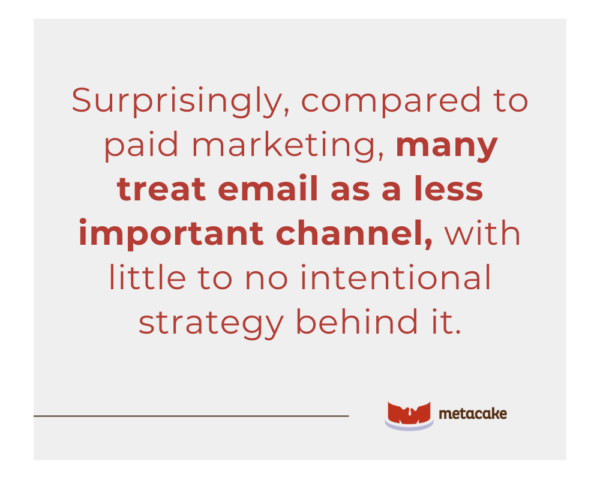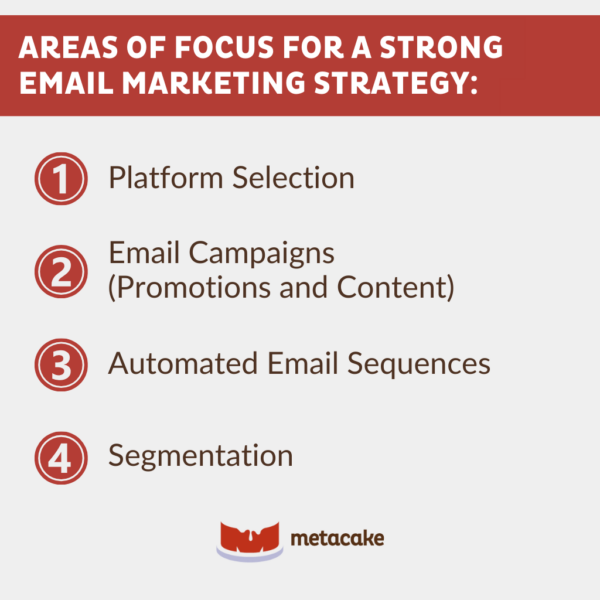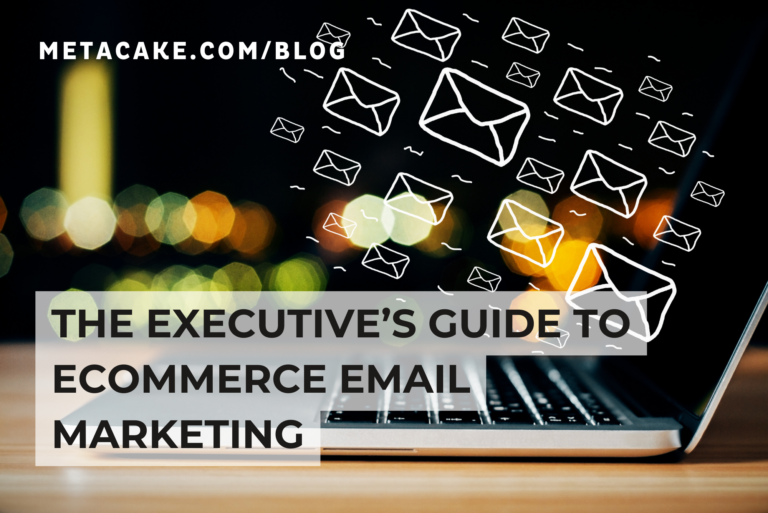If you’re a leader, owner, or executive of a DTC brand, you may view ecommerce email marketing as just another marketing channel. Your team sends promotional emails that make some money, and every once in a while you send some content emails.
You’re probably using an abandoned cart flow to recover lost checkouts. But are you using other key automations that build real customer relationships and drive lifetime value to its fullest potential?
Surprisingly, compared to paid marketing, many treat email as a less important channel, with little to no intentional strategy behind it.
If that’s you, you’re not alone. But you’re missing out on a ton of short- and long-term opportunities by doing it this way.
The truth is that your email list and the email strategy you build are both valuable assets. You need to treat them as such — not undervalue them.
In this post, we’ll explain how to rethink your understanding of email marketing and your email list, as well as why it’s the highest-valued asset in your ecommerce space. We’ll also dive into our top advice on how to guide your team to run a highly effective email marketing program. Let’s get to it!

Why Your Email List Is One of Your Most Valuable Assets
Email is an owned marketing channel (possibly your only owned channel), which is quite different than a paid marketing channel.
You don’t own Facebook, Instagram, Google, or any other platform that you choose to run ads on. Therefore, you have zero control over the outcome or longevity of these channels. Their algorithms and rules change frequently. They even have the potential to shut down your account without much warning.
If you’re a brand that relies on these paid channels for traffic and revenue, that’s a huge vulnerability.
In contrast, your email program is one of the only marketing channels that you truly own and can scale without barriers or risks.
Your goals for your email channel should be to:
- Grow a healthy and engaged list.
- Nurture those relationships at scale to increase loyalty and grow real customer LTV.
- Create predictable revenue based on your marketing and promotions calendar.
Do this, and email will significantly impact your business. In fact, we encourage brands to strive for at least 30% of their revenue to come from email. That (or more) is completely possible if you prioritize this channel.
Is Your Current Email Program Healthy?
Before we dive in, here are some questions to consider when determining how your current email program is performing.
- What is your revenue per email address per send? The sweet spot should be above 10 cents per unique email sent in a campaign.
- What percent of your total revenue does email account for? Email should account for upward of 15% of your total revenue. In healthy, mature programs, this number is upward of 30%. Not there? That means a healthy program could add 30% to your top line.
- What’s your customer LTV (lifetime value)? We like to see customer lifetime value at least 2.5 to 3 times your AOV (average order value). This should grow over time, and email is the front line for accomplishing this.
The Correct Approach to Email Marketing
There are a few things about ecommerce email marketing that you need to understand before we dive into how to create a successful email program.
First, you need to approach email with a proper understanding of its value. When you have a curated list coupled with a winning strategy, email marketing can yield the highest ROI of any other channel in your marketing plan.
There are also very few costs involved. You’ll pay for a platform and for your team to do the work, but that’s it. You don’t pay per send or pay per click like you would on other marketing channels.
Next, when thinking about your list, keep quality over quantity in mind. Of course, the goal is to grow your list as much as possible. But don’t accumulate giant lists of unengaged names.
Building your list as quickly as possible through clickbait and sweepstakes is an old-school method that won’t work. Focus on acquiring a truly interested audience that’ll drive real value, even if it’s small.
It’s also important to realize that a solid email strategy is the best way to develop customer lifetime value (LTV). This is the key to real, healthy growth for any brand, big or small. You’ve probably heard it said that it’s more efficient to re-engage existing customers than to acquire new ones. Well, email marketing is the most intentional and efficient way to do just that.
While communicating with your customers in an effort to grow LTV, you’ll likely find a core audience rise to the top. These are the names that are most active and engaged — the people who consistently open emails, click through to your site, and purchase more than once.
If you treat them well, they’ll shift from being regular customers to raving fans. This is ecommerce gold. Your fans are your most important group of customers, and you can leverage this asset in several areas of your business to drive real sales.

4 Areas of Focus for a Strong Email Marketing Strategy
1. Platform Selection
The email platform you choose is a key decision in your strategy. It needs to be cost-efficient as well as deliver quick and easy value for your team. Here are a few requirements to keep in mind as you decide on the right platform for you:
- Integration: The email platform must integrate well with your ecommerce store so data can flow seamlessly between the two. This is crucial for your program to thrive. This’ll allow you to easily search, store, and report on revenue attributed to email. This’ll also allow you to quickly segment (or group) customers from your email list based on their behaviors and interests.
- Ease of use: Traditional email platforms are over-complicated and waste a lot of time getting emails written and lists created just to allow you to send the campaign. Thankfully, there are newer options out there (like Klaviyo) that are user-friendly and highly efficient. Whatever you choose, your team needs to be able to quickly create effective promotional emails, segment customers based on purchase history or other behaviors, create automated sequences, and report on direct revenue attributed to each email sent.
- Budget: Back in the day, those complex, older platforms we just mentioned would break the bank and have long contracts. That’s not the case anymore. Klaviyo’s subscriptions (our top choice) bill based on your email list size and the number of emails you send per month. This is much less expensive than old-school platforms.
If you’d like to learn more about Klaviyo and things to keep in mind when selecting a platform, read The Complete Klaviyo Review for Ecommerce Email Marketing.
2. Email Campaigns (Promotions and Content)
The second area of focus will be marketing (or promotional) emails. These are one-off emails based on your team’s marketing calendar. If you don’t have a marketing calendar that covers every marketing channel you use, your team needs one ASAP. You’ll never reach your goals if you don’t plan months in advance.
If your team doesn’t use a unified marketing calendar, they’re likely running around in chaos with no clear path to hit revenue goals.
You’re probably already sending marketing emails to announce sales and new product releases, which is perfect. However, it’s important to note that not all marketing emails should focus solely on selling.
We follow a 1:1 ratio of emails that push sales to emails that push valuable, helpful content. Selling non-stop is a sure way to burn out your customers and see unsubscribes increase quickly.
3. Automated Email Sequences
Third, you’ll need automated emails, which are a series of emails that are pre-built and typically include dynamic customization.
Technically, they are sent based on a logic tree where certain messages are sent in response to various actions or behaviors from your customers. These actions and behaviors, such as purchasing a certain product, joining a certain list, or spending a certain amount, act as triggers that prompt these message flows.
Translation: Automated sequences allow you to have personal communications with your customers based on specific actions they’ve taken at scale, which equates to more sales with no additional work or marketing spend.
This may sound complex, but you’ve likely received these types of emails before. The top three sequences you must have running are:
- Abandoned Cart: Triggered when a customer starts checkout but doesn’t complete it. This series of two to three emails follows up on the item/s they left behind with a reminder to complete checkout.
- Welcome Series: Prompted when customers sign up for your email newsletter prior to purchase. These emails tell your brand’s story, show off what you have to offer, and typically include a welcome discount.
- Post Purchase: Triggered by a purchase, this sequence is designed to thank the customer for purchasing, educate the customer on the product and how to use it, and possibly offer a discount for their next order.
You can start simple with the three listed above and eventually get more complex for more specific audiences. For example:
- Once customers reach three or more purchases, you might automatically welcome them to a VIP customer list and treat them to more specific content or offers.
- If a customer hasn’t purchased in a while, you might automatically send them a series of “win-back” emails to showcase what’s new and offer a coupon if they’d like to come back today.
- If a customer buys a product that has complementary items at your store, you could automatically send emails that cross-sell those additional products.
Whether you’re running simple or more complex automations, here’s the key takeaway: Automated email sequences are the most effective way to increase customer lifetime value at scale. And as we mentioned at the top of this article, developing customer lifetime value is critical to extreme growth for any brand.
For more on this, check out our article, 8 Automated Email Campaigns Your Ecommerce Store Needs.
4. Segmentation
The last piece of the puzzle is customer segmentation, which means grouping customers from your list based on certain actions or attributes in order to communicate with them on a more personal level, at scale. For example:
- You might want to send a promotional email only to customers who’ve bought a certain product in the past.
- You may want to send a coupon to customers who haven’t purchased in the last year.
- You may want to thank your top customers.
- You may even use segmentation to poll customers who have bought one product to see if they’d like you to release a better version.
Even if you want to send the same message to your entire list, you could still use segmentation to break your list into different types of customers and tweak the design or copy of your email to appeal to different audiences.
Another important use of segmentation is to exclude unengaged, unsubscribed, or suppressed emails.
For unengaged contacts, there are efforts that can be made to re-engage those names (such as win-back campaigns and flows). But continuing to include these names in all of your regular email sends can cause issues such as spam complaints or a high unsubscribe rate. It also dilutes the engagement metrics and makes it hard to see how engaged your core customers actually are!
So why go to all this effort for segmentation? In short, the more you can tailor your email communication to specific customers, the more effective your emails (and the higher your engagement) will be.
Fortunately, this is a very simple process with a modern email platform built for ecommerce. Platforms such as Klaviyo automatically collect and store all kinds of customer data from your ecommerce store, which allows you to create segments quickly and easily.
Ecommerce Email Marketing: Final Thoughts
There’s a lot that goes into a winning ecommerce email marketing program, but it starts with understanding its potential.
Never underestimate the value of your biggest marketing asset: your customer email list. Used wisely, you’ll be able to acquire new subscribers, grow relationships with current customers, and most importantly, turn those customers into raving fans.
If you’re still not convinced that the ROI is there, think again! We’ve published a case study that breaks down how we used Klaviyo email marketing to grow one client (Groove Life) from brand-new to over eight figures in revenue in just three years.
This job isn’t for an entry-level marketer or an eager intern. It requires experience to strategically grow your list and use it skillfully to make revenue. If you want to win in ecommerce, hire an expert to help get your email marketing strategy in order.
If you prefer to keep email marketing in-house, check out The Ultimate Guide to Ecommerce Email Success. This comprehensive, quick download will show you how to put what we’ve discussed here into action.
It’s the ideal method to ensure your marketing team is on pace for success! So, if you want to build an email marketing program that drives real results, consider investing in this step-by-step guide.
If you need a little extra help, we’re always here for you. Reach out today.
Looking for experienced experts to help guide your email strategy?
Additional Reading:
How We Helped Groove Life Leverage Klaviyo Email Marketing to Explode to 8 Figures in Just 3 Years
9 Easy Email Segmentation Strategies that Increase Conversions
7 Ecommerce Email Marketing Examples to Inspire Your Campaigns
8 Automated Email Campaigns Your Store Needs
6 Ways to Scale Customer Lifetime Value While You Sleep
8 Email Marketing Tips to Make CTR and Open Rates Skyrocket
8 Reasons Klaviyo is a No-Brainer for Ecommerce Companies
The Holy Grail of Ecommerce Success: Creating Lifelong Brand Fans
